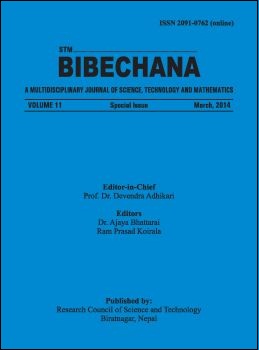Empirical model based on meteorological parameters to estimate the global solar radiation in Nepal
DOI:
https://doi.org/10.3126/bibechana.v11i0.10376Keywords:
Global solar radiation, Clearness index, Relative humidity, Temperature, Linear regression Relation, Empirical modelAbstract
Solar radiation is the best option and cost effective energy resources of this globe. Only a few stations are there in developing and under developed countries including Nepal to monitor solar radiation and sunshine hours to generate a rational and accurate solar energy database. In this study, daily global solar radiation, and ubiquitous meteorological data (temperature and relative humidity) rather than rarely available sunshine hours have been used for Biratnagar, Kathmandu, Pokhara and Jumla to derive regression constants and hence to develop an empirical model. The model estimated global solar radiation is found to be in close agreement with measured values of respective sites. The estimated values were compared with Angstrom-Prescott model and examined using the statistical tools. Thus, the linear regression technique can be used to develop model at any location in the world. The resultant model may then be used to estimate the missing data of solar radiation for the respective sites and also can be used to estimate global solar radiation for the locations of similar geographic and meteorological characteristic.
DOI: http://dx.doi.org/10.3126/bibechana.v11i0.10376
BIBECHANA 11(1) (2014) 25-33
Downloads
Downloads
Published
How to Cite
Issue
Section
License
This license enables reusers to distribute, remix, adapt, and build upon the material in any medium or format for noncommercial purposes only, and only so long as attribution is given to the creator.




